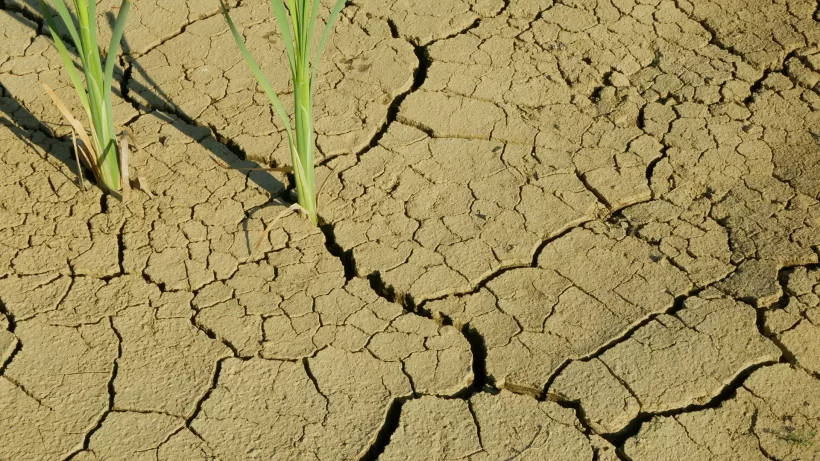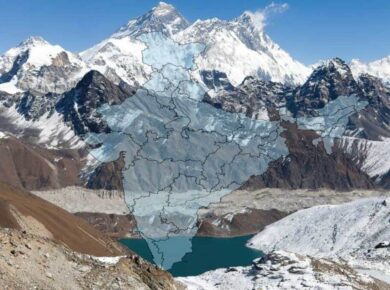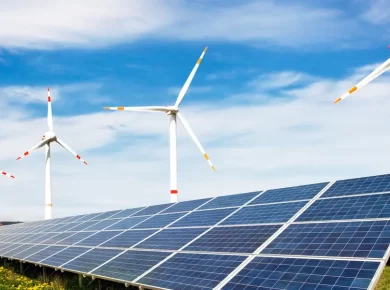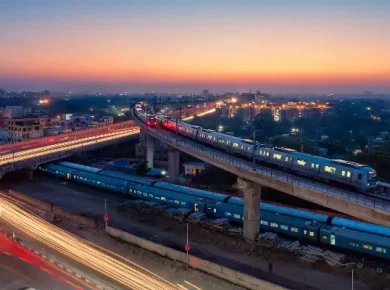Soils in India
- Soil is the uppermost layer of Earth’s crust.
- Soil is the medium in which plants grow and thus it supports the lives on earth.
- A number of factors contribute to the soil formation and fertility viz.
| Parent rocks |
|
| Climate |
|
| Slope |
|
| Time |
|
|
|
The soils of India on the basis of their formation are divided in the following two broad categories viz.
- Residual Soil > Which form at the place of their origin for ex. Black soils
- Transported Soil > Which are transported from place of their formation for ex. Alluvial soils
Types of Soils Found in India
Alluvial Soil
- Formed by depositional work of rivers valleys, flood plains & deltas
- Highly fertile Riverine soils > Transported type
- Largest Tract > Satluj Ganga Plains
- Less connection with Parent material
- Rich in Potash but deficient in Nitrogen & Humus content
- Good for both rabi and kharif crops
- In delta region, they are ideal for jute cultivation
- Best for cereals & Pulses
- Khadar > Deposited by flood annually (Fresh silt) > non porous, clayey and loamy
- Bhangar > Above flood level; well drained & drier > coarse in nature, contain kankar (lime nodules), pebbles, gravels
- Forms 22.16 % of the total land area of the country
Black Soil
- Formed By solidification of Lava
- Mainly found in Deccan Plateau
- Also known as black cotton soil or Regur soil
- Black colour is due to its iron content, derived from plutonic lava materials
- Highly fertile (< Alluvial)
- Residual type of Soil
- Deficient in organic content, phosphorus, nitrogen
- Rich in lime and iron, magnesia and alumina; also contains Potash
- Highly clayey and impermeable > Highly moisture retentive
- Ploughed in dry season as on evaporation cracks develop for better seed penetration
- Regions > Maharashtra, Gujrat, Madhya Pradesh, Andhra Pradesh, Parts of Tamil Nadu
- Forms 16.6 % of the total land area of the country
Red & Yellow Soil
- Formed by weathering of Igneous (crystalline) & metamorphic rocks
- Less fertile than Alluvial & Black soils
- Lacks water retentive capacity
- Reddish in color due to presence of Feo (Ferrous oxide)
- Looks Yellow in Hydrated form
- Transported type of soil
- Deficient in nitrogen, lime, magnesia, humus and phosphate
- Rich in potash and become fertile with the proper use of fertilizers and irrigation
- Are porous, aerated & friable in nature
- Regions > Periphery areas of Deccan Plateau viz. Chhotanagpur plateau, Telangana, Nilgiris, Tamil Nadu, Karnataka, Andhra Pradesh
- Suitable for the cultivation of millets, pulses, Linseed, tobacco etc.
- Forms 10.6% of the total land area of the country
Laterite Soil
- Formed under conditions of high temperature and heavy rainfall with alternate wet and dry periods.
- Thus its formation takes place strictly under monsoon conditions
- Formed by leaching away of siliceous matter
- With rain, Lime & Silica leaches away, leaving insoluble Feo & Al compounds > Desilication
- Humus content of soil is fast removed by bacteria which thrive well in high temp.
- Residual type of soils, formed by leaching in areas of heavy rain
- Mainly found in Highland or Plateaus with heavy rainfall
- Not useful for agriculture except for plantation crops like Tea, Rubber, Coffee & Cashews
- Used as building material & in making bricks
- Are of Coarse texture with soft & friable nature
- Poor in Lime, Nitrogen, Magnesium & Humus content; Rich in Feo & Alumina
- Regions > Meghalaya, Karnataka, Kerala, Tamil Nadu, hilly regions of Assam, Rajmahal hills and Chhota Nagpur plateau
- Forms 7.2 % of the total land area of the country
Saline / Alkaline Soil
- Found in arid or semi-arid conditions along with water logged areas
- Highly saline due to dry climate, poor drainage & high evaporation
- Infertile & does not support vegetative growth
- Found at Bihar, Rajasthan, UP., Punjab, Haryana, Maharashtra
- Salinity also Caused due to excessive irrigation in dry conditions which promotes capillary action
Arid Soil
- Found in areas with rainfall < 50 cm
- Sandy, porous, coarse & rich in salts
- Generally saline due to high evaporation
- Covered with thick brown mantle which inhibits soil growth
- Originated from the mechanical disintegration of the ground rock of by deposition by wind
- Low rainfall and high temperature are reasons for the formation of this soil
- Mainly in SW Haryana & Punjab and W – Rajasthan
- Actually fertile, water being the only limiting factor
- Cereals grown are Jowar, Bajra, Ragi & Oil seeds > Drought resistance crops
- Forms 3.9 % of the total land area of the country
Mountain Soils
- Prone to soil erosion > top soil getting washed away due to the steep slopes of the mountains after a heavy rainfall
- These soils are mostly thin and infertile
- Include peat, meadow and forest hill soils
- Rich in humus but deficient in potash, phosphorous and lime
- Generally loamy & silty on valley side and coarser in upper slopes
- Useful for Tea, coffee, spices and tropical fruits
- Regions → Jammu and Kashmir, Himachal Pradesh, Uttaranchal, Assam, Sikkim, Arunachal Pradesh
Peaty / Organic Soil
- Found in high rainfall + high humid areas of WB, Orissa & Kerala
- Rich in Humus & organic content, sometimes alkaline too
- Heavy, Dark & acidic
Salinity of Soils
- Predominance of Chloride & sulfates of N, Ca & Mg, Esp. of NaCO3
- Decreases soil fertility, Quality of fodder becomes poor, Difficulties in Housing & road construction
- Addition of Gypsum (Converts Alkalis to compounds), Addition of rice husk & rice straw also counters alkalinity by forming light acids
- Crop rotation involving Daincha (Green Fodder) also counters salinity.
Soil Erosion
|
Effects of Soil Erosion
|
Prevention of Soil Erosion Techniques
Terrace Farming
- On hilly slopes, terraces act as bunds and prevent the soil from being washed away
- Farming is done on a unique step like structure and the force of water running off is slowed down
- Terraced farming is more common on small farms and in underdeveloped countries, since mechanized equipment is difficult to deploy in this setting
Contour ploughing
- Land should never be ploughed up & down as it increases erosion
- Ploughing along contours on a slope prevents soil being washed away by rainwater or by surface run off
- Contours act like bunds and thus prevents soil erosion by allowing water to slowly penetrate the soil
- Terraces are levelled into step like small fields with even slope
Contour barriers / Contour trenching
- Contour strips which intercept downslope flowing water and soil particles
- Several 2 feet by one-foot trenches are formed across the slopes at suitable intervals
- Tree seedlings are to be planted above the trench
- These barriers slow down the water movement and reduce its erosive force
- They also filter out and trap many of the suspended soil particles, keeping them from being washed out of the field
Afforestation
- Planting of trees along the edges of the fields, the waste land and on steep slopes to prevent soil erosion
- Also to enhance the capacity of the soil to retain water
Shelter Belts
- A line of trees or shrubs planted to protect an area, especially a field of crops, from fierce weather
- Farmers plant trees in several rows to check wind erosion
- Also known as wind breaks
Cover crops / Crop rotations
- Cover crops such as legumes, white turnip, radishes and other species are rotated with cash crops to blanket the soil year-round
- Act as green manure that replenishes nitrogen and other critical nutrients
- Also help suppress weeds & increase soil fertility.
No-till farming
- Also, called zero till age or direct drilling
- A way of growing crops or pasture from year to year without disturbing the soil through tillage
- Increases the amount of water that infiltrates into the soil
- Also increases organic matter retention and cycling of nutrients in the soil
- keeps soils anchored in place rather than having bare ground exposed to wind and water
Strip Cropping
- Crops are grown in alternate strips of land to check the impact of the winds.
- It is used when a slope is too steep or when there is no alternative method of preventing soil erosion.
- Contour strip cropping > Cultivation of soil protecting crops in strips alternating with erosion permitting crops. The strips should be across the slope.
- Field strip cropping > Plants are cultivated in parallel strips across the slopes
Mulching
- Mulches are materials placed over the soil surface to maintain moisture and improve soil conditions
- A protective layer of a material that is spread on top of the soil
- Mulches can either be organic — such as grass clippings, straw, bark chips, and similar materials
- Or inorganic — such as stones, brick chips, and plastic
Construction of Dams
- Rivers causes soil erosion
- Dams are built in the upper course of rivers to control erosion of soil
- This would check the speed of water and thereby save soil from erosion
For more updates, explore the Geography . Feel free to share your thoughts and comments.
If you’re passionate about building a successful blogging website, check out this helpful guide at Coding Tag – How to Start a Successful Blog. It offers practical steps and expert tips to kickstart your blogging journey!














6 comments
thankyou very much to share the knowledge.
Sir a small correction.. alluvial soil is 43.36 % red soils 18.46% black soil 15% laterite 3.7% according to ICAR..thank you good post..
Hello iasmania,
I am a new aspirant.
I have planned to take prelims 2017 under your guidance, so i request you to be doubly sure of the data you have uploaded. As madhu had previously pointed out, please correct those errors.
It is people like us who will recommend stuff to others.
So please be sure that i am recommending a trustworthy source.
Thanking you.
nice work
awesome site , appropriate for the particular information given on this site
as per diagram red soils are more area than black soils….percentage mentioned. pls mention correct percentages